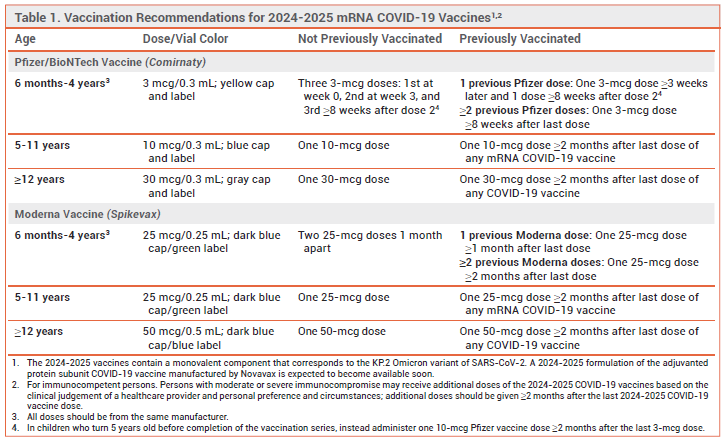ISSUE1711
- Mark Abramowicz, M.D., President has disclosed no relevant financial relationships.
- Jean-Marie Pflomm, Pharm.D., Editor in Chief has disclosed no relevant financial relationships.
- Describe the 2024-2025 formulations of the Pfizer and Moderna COVID-19 vaccines and discuss the recommendations for their use.
New 2024-2025 formulations of the mRNA COVID-19 vaccines manufactured by Pfizer/BioNTech (Comirnaty) and Moderna (Spikevax) that more closely target currently circulating variants have been licensed by the FDA for persons ≥12 years old and made available under FDA Emergency Use Authorizations (EUAs) for use in persons 6 months to 11 years old.1-3 A 2024-2025 formulation of the adjuvanted protein subunit COVID-19 vaccine manufactured by Novavax is expected to become available soon for persons ≥12 years old.
THE NEW VACCINES — The new formulations are monovalent vaccines that code for the spike protein of the KP.2 Omicron strain of SARS-CoV-2. KP.2 is a member of the "FLiRT" variant family; as of mid-August 2024, FLiRT variants (e.g., KP.2, KP.2.3, KP.3, KP.3.1.1, LB.1) were causing the majority of COVID-19 cases in the US.4,5
CLINICAL STUDIES — No clinical studies evaluating the immunogenicity or effectiveness of the new vaccine formulations are available. Licensure and authorization of both vaccines were based on the immunogenicity, safety, and efficacy of previous vaccine formulations.1-3
ADVERSE EFFECTS — Adverse effects of earlier versions of the mRNA COVID-19 vaccines have included injection-site reactions, fatigue, irritability, fever, chills, muscle and joint pain, headache, vomiting, decreased appetite, and lymphadenopathy. Severe allergic reactions and Guillain-Barré syndrome have been reported. Myocarditis and pericarditis can occur; the incidence is highest in adolescent and young adult males.6
DOSAGE RECOMMENDATIONS — Generally, persons ≥5 years old should receive a single dose of a 2024-2025 vaccine formulation ≥2 months after their previous COVID-19 vaccine dose. Children 6 months to 4 years old who have already received ≥2 Pfizer or Moderna vaccine doses should receive a single dose of the corresponding 2024-2025 vaccine ≥8 weeks (Pfizer) or ≥2 months (Moderna) after their most recent dose. Those 6 months to 4 years old who received <2 previous doses should be given additional doses until they have received 3 total doses of the Pfizer vaccine or 2 total doses of the Moderna vaccine. Children 6 months to 11 years old with immunocompromise (solid-organ transplant recipients and equivalent) should receive at least 3 total age-appropriate COVID-19 vaccine doses, including at least 1 dose of a 2024-2025 formulation. Dosage recommendations for the updated vaccine formulations are summarized in Table 1.2,3
CDC RECOMMENDATIONS — The CDC recommends that all persons ≥6 months old receive either of the two 2024-2025 mRNA COVID-19 vaccines.7
- FDA News Release. FDA approves and authorizes updated mRNA COVID-19 vaccines to better protect against currently circulating variants. August 22, 2024. Available at: https://bit.ly/3T3eGzP. Accessed August 28, 2024.
- FDA. Fact sheet for healthcare providers administering vaccine: Emergency Use Authorization (EUA) of Pfizer-BioNTech COVID-19 vaccine (2024-2025 formula), for 6 months through 11 years of age. August 22, 2024. Available at: https://bit.ly/4g2dQxa. Accessed August 28, 2024.
- FDA. Fact sheet for healthcare providers administering vaccine: Emergency Use Authorization (EUA) of Moderna COVID-19 vaccine (2024-2025 formula), for individuals 6 months through 11 years of age. August 2024. Available at: https://bit.ly/3YZmmqo. Accessed August 28, 2024.
- COVID-19 Real-Time Learning Network. COVID-19 variant update. August 21, 2024. Available at: https://bit.ly/4cLGAqW. Accessed August 28, 2024.
- CDC. COVID data tracker. Variant proportions. August 27, 2024. Available at: https://bit.ly/3Ka3HhH. Accessed August 28, 2024.
- CDC. Clinical considerations: myocarditis and pericarditis after receipt of COVID-19 vaccines among adolescents and young adults. October 10, 2023. Available at: https://bit.ly/3yXicot. Accessed August 28, 2024.
- CDC. Use of COVID-19 vaccines in the United States: interim clinical considerations. August 23, 2024. Available at: https://bit.ly/3yKjLWV. Accessed August 28, 2024.

